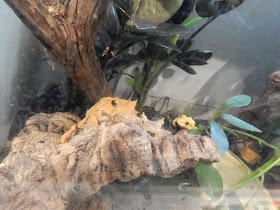As mentioned previously, the organizers of this year's SVP had arranged free entry to the Cincinnati Zoo for conference attendees. I ended up going to the zoo twice during the conference period just so I could see (almost) everything. I was quite impressed; the Cincinnati Zoo isn't massive, but it boasts a large diversity of species (many of which I'd rarely or never seen in other zoos) housed in generally well-designed exhibits.
One of the highlights for me was this expansive grassy habitat in the African section of the zoo, which features multiple species of large African birds (as well as lesser kudu). Here are just a few of the inhabitants, starting with a flock of pink-backed pelicans.
A gray crowned crane.
A lappet-faced vulture.
Some Rüppell's vultures.
Some eastern crested guineafowl.
A good look at the two-toed feet of a common ostrich.
Something I noticed about several of the exhibits at the Cincinnati Zoo was that they had mirrors placed within them, presumably as enrichment for the animals.
Another exhibit nearby is home to African wild dogs.
As avian paleontologists, my labmates and I were naturally eager to check out the bird house. Just outside of it is a habitat for Cape Barren goose, an unusual-looking Australian waterfowl.
A salmon-crested cockatoo perched above.
Unfortunately, I did not get many satisfactory photos inside the bird house itself, as wire mesh, wet glass, and the fast movements of the birds themselves made it challenging to do so. However, I very much enjoyed what I saw. Highlights included two walk-in aviaries (one containing Neotropical birds, the other birds of Southeast Asia and Australia), as well as several seabird exhibits with underwater viewing.
It was quite surreal to see these Inca terns perched on a branch and exhibited in a tropical rainforest setup.
A tawny frogmouth. I will always stop for strisoreans.
A helmeted hornbill.
In addition to a nice bird collection, the Cincinnati Zoo also houses a diverse range of primates. Here are some Coquerel's sifakas, also known to North Americans of a certain age as Zoboomafoo.
The zoo has a building dedicated to wildlife from the wetlands of the Southeastern United States with Florida manatees as the centerpiece, one of the few places outside of Florida where America's afrotheres can be seen. The open-mouthed (probably prey-luring) pose of this alligator snapping turtle was quite striking.
Just outdoors are some exhibits for hoofed mammals, such as these Visayan warty pigs.
A pair of bongo antelope.
Several displays near the entrance of the zoo provided homes for large raptors, including this Andean condor.
The reptile (and amphibian) house also had a nice selection of species, including these Titicaca water frogs. They are able to breathe through their baggy skin in the cold water where they live.
A juvenile Komodo dragon, having mostly lost its hatchling coloration but still far from full size.
At the center of the reptile house is an open-topped habitat for this Chinese alligator.
One of my favorite exhibits at the zoo overall was probably the nocturnal house, but photographing the inhabitants in the dark was of course difficult. I had to try and get a picture of this aardwolf though, this being the first time I've seen this species. It is the smallest of all extant hyenas and feeds almost entirely on termites. Hmm, I wonder why that might be of interest to me...
Most of the outdoor exhibits next to the nocturnal house featured wild cats (including mountain lions, tigers, and snow leopards), which we got some excellent views of. However, I was unsurprisingly most taken by this Eurasian eagle owl.
As the site where the last passenger pigeon and Carolina parakeet passed away, the Cincinnati Zoo has dedicated a poignant memorial to these species.
The insect house is quite large and contains more than just arthropods. It also displays, for example, these Solomon Island leaf frogs (eyeing a feeder cricket).
A black-breasted leaf turtle. According to exhibit signage, this species can rotate each of its eyes independently, similar to a chameleon.
There is no lack of actual arthropod displays in the insect house though. Here is a Baja whipspider.
Some giant water bugs (including males carrying eggs).
A Peruvian firestick, apparently a poisonous stick insect that has evolved bright colors to warn predators of its toxicity.
Another building nearby is primarily dedicated to exhibiting lizards, such as this quince monitor.
The star of the show here is this adult Komodo dragon. It lives in perhaps one of the most unexpected mixed-species zoo habitats I've seen, sharing its exhibit with zebra finches. Presumably, they are too small and quick to be seen as worthwhile prey. They certainly didn't seem too bothered from what I saw of them, actively fluttering to the exhibit floor to collect nesting material.































As Komodo dragons, or at least there direct ancestor, were once present on the Australian mainland keeoing them with Zebra finches is not quite out of place on zogeographical grounds. If the Peruvian Fire stick is the Oreophotes species I think it is I have kept them myself - they feed on vaious ferns which I suspect are the source of their toxic defenses.
ReplyDeleteThe Sunda zebra finch, which is the (sub)species in the exhibit, does overlap in range with the Komodo dragon in the wild, so it's not at all a stretch biogeographically. I was more surprised by the choice to keep a bird of any kind in an enclosed space with the Komodo dragon, though as I surmised there probably isn't much to worry about in this case.
Delete